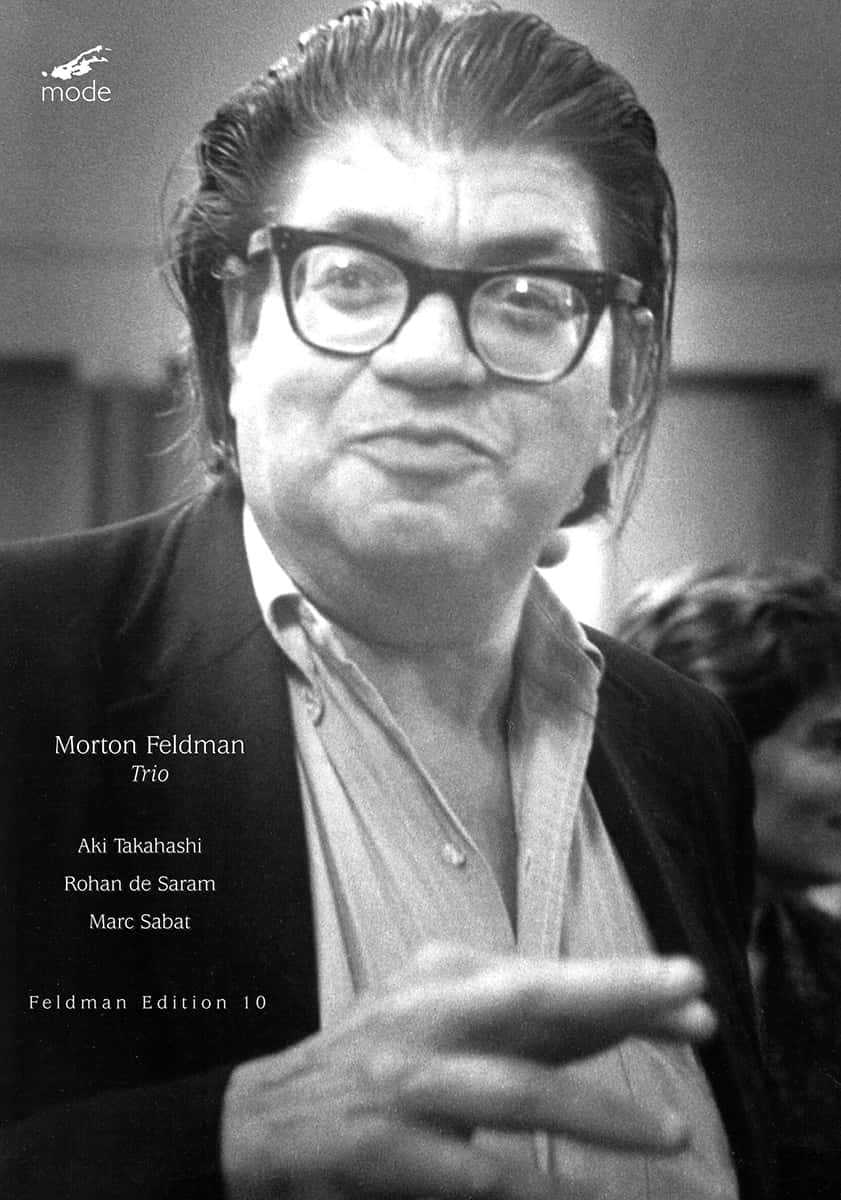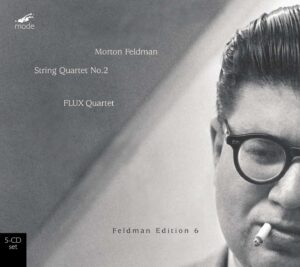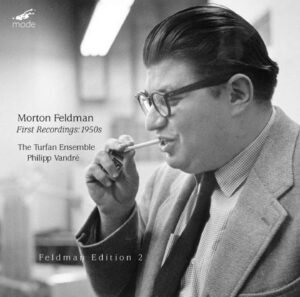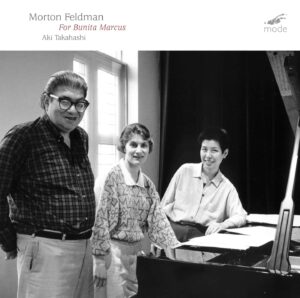Feldman Edition 10-Trio - DVD
Morton Feldman
Trio (1980) 1:45:22
Aki Takahashi, piano
Rohan de Saram, cello
Marc Sabat, violin
The expansive length of Feldman’s Trio (1 hr., 45 min., 22 sec.) requires a new approach to listening, which takes scale, the physical experience of sound, and novel uses of musical memory into consideration. With his delicate manipulation of musical materials, Feldman blurs the listener’s sense of time as their musical memory struggles to distinguish between past and present sounds – listeners are free to lose themselves in the beauty of each musical moment.
Aki Takahashi and Rohan de Saram (formerly of the Arditti Quartet) both worked closely with Feldman. Marc Sabat is among today’s great Feldman interpreters, having recorded Feldman’s complete music for violin & piano on Mode.
Available as a specially priced 2-CD set or complete on a single DVD with full video and extras. This is the only readily available performance of the Trio available in the U.S.A.
Original recording in superb 96khz, 24-bit sonics. Two very distinct mixes were made for the surround and stereo versions. The natural reflected hall sound – which would typically be in the rear surround speakers – is not very dramatic because of the basically quiet nature of the Trio. Instead, for the surround mix, we chose to place the listener in an intimate perspective with the musicians: directly between the violin and the cello, with the piano in front. For the stereo mix, the violin and piano are clearly separated left and right to accentuate their interplay. Feldman’s use of extended string techniques can blur the timbral separation between cello and violin, creating unified sonic events exploring the qualities and possibilities of the combination of instruments – for example, utilizing the resonance of the piano and the sustaining qualities and dynamic control of the strings. These subtle nuances are brought out by the detail of the recording.
Detailed essay on the work by Sabine Feisst included in the booklet.
SPECIAL DVD FEATURES:
• The recording sessions were filmed and directed by Tim Chu in High Definition Video, widescreen format. The intimate video allows the viewer to enjoy the subtle interplay of the performers.
• BONUS video essay on Feldman and the Trio by the noted German composer and Feldman expert Walter Zimmermann, who hosted the premiere of the Trio at his Beginner’s Studio concerts in Köln (31-minutes).
• The DVD format allows the 105-minutes of the Trio to be enjoyed continuously on one disc without a break.
• 5.1 Surround sound, presented in Dolby and 24-bit DTS. Also a dedicated Dolby stereo mix opt
Reviews
Album: Morton Feldman, Trio (Mode)

Written in the early Eighties, Trio was one of Feldman’s first long-form pieces employing a conventional chamber palette of violin, cello and piano. It involves neither epic musical narrative nor the tedium of process music, its 105 minutes instead built from his usual small-scale blocks of sound.
This latest interpretation by Aki Takahashi, Rohan de Saram and Marc Sabat is full of Feldman’s usual tropes – the constantly shifting meter, the favouring of decay over attack, the “crippled symmetry“ of repetition (in some cases, the same few notes played more than 50 times in succession, with subtle variations of touch and timing) without the imposition of minimalist pulse, and the evaporation of timbres at their upper extremes – resulting in a typically focused, absorbing and meditative experience unlike any other.
– Andy Gill, The Independent, Friday, 19 March 2010
www.independent.co.uk
MORTON FELDMAN: Trio
Performance: 
Sound: 
At an hour and 45 minutes, Morton Feldman’s Trio (1980) is a chamber work of extraordinary duration, comparable in length and mood to his other marathon compositions, For Philip Guston, For John Cage, and For Christian Wolff, though it does not approach the heroic scale of his six-hour String Quartet II. One interesting aspect of Feldman’s thinking is that his narrow dynamic range and close intervals are in inverse proportion to his expansive temporal dimension: for him, quiet sounds and small pitch relations were the norm, but his late music stretched out over vast timespans and had the effect that it didn’t really build to a climax or go anywhere, but existed in a seemingly timeless yet constantly cycling stasis. The consistency of tone colors and gentleness of the pointillistic writing give the Trio a strong meditative quality, and it is quite easy to listen to, even though most of the chords are built on minor seconds and there are no real themes or even melodic fragments to follow. Indeed, the airiness of the music suggests that the soothing ambience is perhaps more important than any other musical aspect, and sustaining this delicate sound world requires the sensitivity and control that violinist Marc Sabat, cellist Rohan de Saram, and pianist Aki Takahashi bring. From barely audible pizzicati to piano chords that are repeated with the subtlest changes in emphasis, this group is steady through the entire performance, and listening to their evanescent playing is a pleasure that any Feldman fan will appreciate. Mode’s reproduction is excellent for its responsiveness to the slightest musical effects and for its clean studio sound.
– Blair Sanderson, www.allmusic.com, November 2010 http://www.allmusic.com/
Album: Morton Feldman, Trio (Mode)

Written in the early Eighties, Trio was one of Feldman’s first long-form pieces employing a conventional chamber palette of violin, cello and piano. It involves neither epic musical narrative nor the tedium of process music, its 105 minutes instead built from his usual small-scale blocks of sound.
This latest interpretation by Aki Takahashi, Rohan de Saram and Marc Sabat is full of Feldman’s usual tropes – the constantly shifting meter, the favouring of decay over attack, the “crippled symmetry“ of repetition (in some cases, the same few notes played more than 50 times in succession, with subtle variations of touch and timing) without the imposition of minimalist pulse, and the evaporation of timbres at their upper extremes – resulting in a typically focused, absorbing and meditative experience unlike any other.
– Andy Gill, The Independent, Friday, 19 March 2010
www.independent.co.uk
MORTON FELDMAN: Trio
The Japanese experimental guitarist Tetuzi Akiyama has commented that he felt compelled to make mid-tempo, moderate volume music because everyone around him was working in extremely loud or extremely quiet sounds. The need to rebel, in a sense, forced him into breaking old ground.
It’s a similar position to the one Morton Feldman found himself in a half century earlier. With the minute having been explored a generation earlier by Anton Webern, and with his peers seemingly more than willing to adhere to the dictates of the LP, Feldman began to grow interested in creating exceedingly long works. (The similarity doesn’t end there, either. As much as Feldman’s compatriot John Cage is celebrated, in many ways it’s Feldman the formalist, with his use of sound and silence is extremely deliberate — an exhibition of ego, as Cage might accuse — who is a truer progenitor of the new school of minimalist improvisation.)
To cite the man himself (as quoted in Give My Regards to Eighth Street: Collected Writings of Morton Feldman, published by Exact Change in 2000):
My whole generation was hung up on the 20- to 25-minute piece. It was our clock. We all got to know it and how to handle it. As soon as you leave the 20- to 25-minute piece behind, in a one-movement work, different problems arise. Up to one hour you think about form, but after an hour and a half it’s scale. Form is easy — just the division of things into parts. But scale is another matter. You have to have control of the piece — it requires a heightened level of concentration. Before my pieces were like objects; now they’re like evolving things.
Trio for violin, cello and piano was composed in 1980, is among Feldman’s first experiments in extended duration, and is seen as marking the beginning of his late period works, from 1979 until his death in 1987. And while it’s all too easy in discussing Feldman to get preoccupied with on clock-watching, the roughly two-hour Trio was followed in 1984 by the four-hour For Philip Guston and the oft-cited six-hour String Quartet No. 2. But what matters, of course, is not how long the theater is rented out for but what’s done with it once you’re there. Central to the Trio (and to Feldman’s ideas about use of scale) is the fact that the piece is a single movement; There’s no time open for a regrouping of wits or a realigning of motifs. It is a singular expression. Rather than boldly announcing the next thematic variation, then, Feldman is constantly in flux, working within palette and pace, making subtle realignments and shifts in emphasis.
In that sense, the use of repetition is far from an elongating device. The instrumentalists get locked into patterns — in unison, in succession, or sometimes in isolation — not to create scale but to explore it, as if to say “We couldn’t have a mountain were it not for each of these stones.”
At the same time, however, there’s a curious irony to Feldman’s mountain climbing. The composer also wanted to eschew the dramatic underpinnings of concert music (notably that of Boulez), and yet it’s the drama of his extended works that make them so majestic, so mountainous. For duration without drama, see (for example) Warhol’s film Empire, a work of a very different emotive impact than the Trio. Feldman’s long pieces, in other words, are far from drones. They are filled with suspense. And in fact, the Trio is filled with murder-mystery string swells. Certainly the composer isn’t responsible for the projections of pop culture, but at the same time it’s hard to imagine that in 1980 Feldman wouldn’t have recognized the baggage Bernard Hermann had attached to stabbing violins. And indeed, suspense is Feldman’s mojo. His pace allows ample time to wonder what will happen next. No Mozartian filigrees here! The music is, literally, suspended in time.
Mode’s 2006 recording of the performance by violinist Marc Sabat, cellist Rohan de Saram and pianist Aki Takahashi is gorgeously warm and intimate. The only shame is that, with Feldman having despised the confines of the LP side, the 105-minute performance should be spread across two CDs. With the possibility of DVD-audio release, technology is finally catching up to Feldman’s vision.
– Kurt Gottschalk, www.squidsear.com, 3 November 2010






